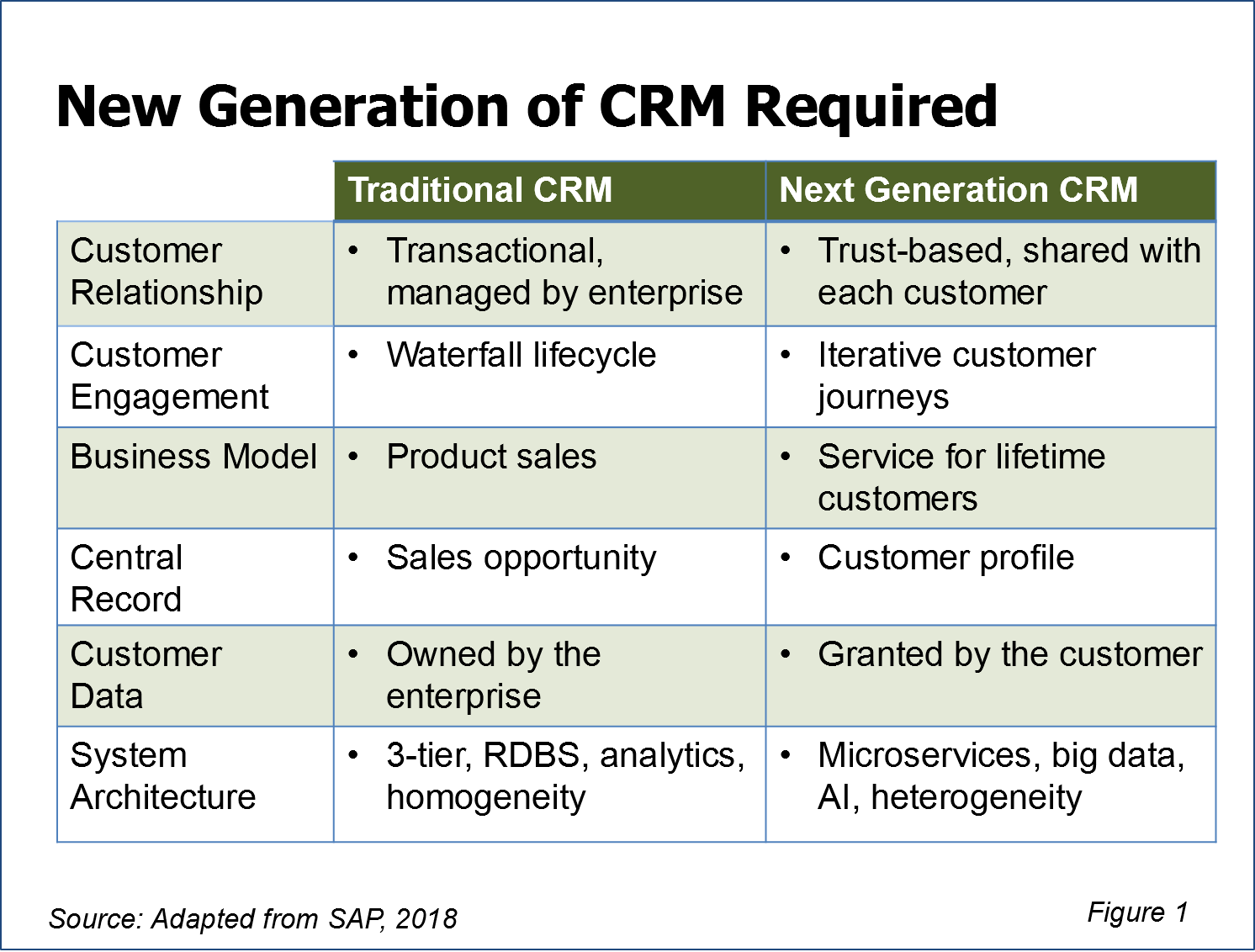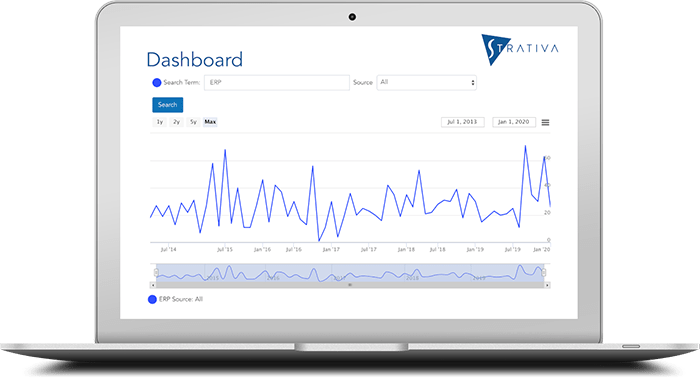
Businesses have always worked hard to attract new customers and build loyalty. Starting with Siebel Systems in 1993 and to the present day, most major software companies have been building customer-relationship management (CRM) solutions focused on automating sales and marketing processes to support those objectives.
But it’s been a long time since Siebel first introduced CRM as a category and even since Salesforce first brought CRM to the cloud. Online commerce has exploded, most consumers are engaged in some way on social media, and customers have higher expectations about what they want and how quickly they want it.
With so much having changed in the marketplace, have needs for CRM changed as well? Is it time to rethink CRM? According to many observers, the answer is yes.
The latest to shine the spotlight on the changing needs for CRM is SAP. At its recent Sapphire Now user conference in Orlando, SAP executives pointed to six ways that CRM systems must change, as shown in Figure 1.
Trust-Based Customer Relationships
Successful businesses have always depended on their customer relationships. However, early CRM systems were transaction oriented, treating customers based upon the number of sales opportunities, volume of purchases, and revenue earned.
Today, customer relationships are starting to look different. With so much electronic commerce, businesses can now gain much more information about the customer in every transaction. But now, companies must use this information in a proper manner.
Businesses have to get the handling of personal information right and maintain the trust of customers. For in today’s world of social media, a company’s brand can be damaged quickly. That damage is costly to remediate, and sometimes it can’t be saved. Moreover, there are so many other businesses vying for the attention of the same customer, and that consumer can now quickly go elsewhere.
Businesses will have to be innovative about how they can use their data to deliver additional value to customers. For example, some utility companies have enhanced their monthly invoices to not only show customers their consumption levels year-over-year, but also how that usage compares to their neighbors. This helps customers make better decisions around energy consumption. The monthly invoice is now more than a statement of what the customer owes but delivers real value.
Customer Engagement as Iterative Journeys
When CRM systems first came on the scene, sales representatives typically took a series of sequential steps (a “waterfall” process) to turn a potential sales opportunity into a sales order. The process was more about how the company wanted to engage the customer rather than how the customer wanted to engage with the company.
But today, customer engagement is more about facilitating a series of customer experiences that help maintain that customer’s loyalty, while addressing the customer’s current and future needs. Businesses are learning how to bring personalized experiences to the customer without being too invasive. It is a matter of not “being too creepy” in that interaction, as SAP’s Alex Atzberger said in the Sapphire opening session. To maintain this relationship with a customer, there needs to be an even tighter integration of CRM, ERP, and other business systems, as well as the processes ingrained in those systems.
As these systems become more integrated, service personnel can utilize the data to create a unified customer experience. For example, imagine a customer having a problem with a recent purchase, causing her to withhold payment. Rather than simply sending a late notice that could exacerbate the situation, the accounting staff could send an email to the customer extending payment terms because they can see that the customer has been working with the service department to resolve the problem. Once the issue with the original purchase is rectified, the company’s empathy and connected business processes might help the sales team during the next encounter. These iterative customer journeys are only possible if the systems and the processes are well-connected.
Service-Oriented Business Model
In the past, the product was king. The philosophy was to have the right product with enough features and options to draw buyers. And then, the following year, bring out a new model and entice the customer to upgrade.
But now, the product sale is no longer the key to the customer. The new business model is all about creating a unique user experience whenever that customer is engaged. Extended service offerings that enhance the use of a product through software applications and extended data sharing for analysis is the new driving focus. Businesses are moving from mass-marketing to segmented (or directed) marketing. This requires that businesses have the right data to deliver relevant content to those segmented customers.
The challenge is still in getting the attention of the consumer. Even with companies attempting to move to individual-focused marketing, the question still remains: How does a company do that successfully when that customer is bombarded with so much information? Eventually, artificial intelligence and machine learning may help business get there, but today’s AI/ML capabilities are still far from reaching that goal.
Customer Profile the Central Record
Early CRM systems focused on giving the organization visibility into opportunities and a process of turning an opportunity into a sale. Marketing and sales efforts looked to leverage a product-centric offer to as many customers as possible to generate new sales opportunities. The opportunity record was at the heart of the system.
But today, it is no longer productive to start with the sales opportunity. Rather, make the customer profile the central record. Starting with determining who the customers are, what their needs are, and how their buying patterns demonstrate unique traits and behaviors.
Businesses can then determine how to satisfy the need for that customer in a unique manner before the competition does. This means putting the customer record at the center of every interaction, no matter if it is a digital interaction, sales rep interaction, product interaction, or field service interaction. All the transactions must be captured, consolidated, and analyzed to give a complete view of the customer.
Use of Customer Data Granted by the Customer
In the past, companies used major enterprise systems to collect and hoard customer transactional information. Many organizations have spent much time, energy, and money to protect this information from their competitors and even from their own supply chains. They viewed this data as a competitive edge and their intellectual property. They could do whatever they wished to do with it.
But now, the new General Data Protection Regulation (GDPR) in the European Union has put a focus on consumers having control over their personal information. New CRM systems will need to bring together data acquired through business transactions, as well as records of the customer’s consent and preferences, to drive the next best business interaction regardless of the channel. Consumers want to know what type of data the businesses have, how it is being used, and where it is stored. Customers must be able to grant consent and withdraw consent.
Next Generation System Architecture
The evolution from single, large mainframe computing platforms to a client-server architecture allowed businesses to build more efficiencies in broader areas of the business, such as sales management, that were often maintained as independent systems on separate platforms. Along with the maturing of hardware and software came the advancement of how data was gathered, used, and stored. We moved from flat files that required extra effort to bring meaning to relational databases that provided a structured view of information.
The demand for relevant information and data is always increasing. Businesses are now drawing from multiple sources of public and private data ranging from public weather databases, social media, and private customer data. All of this data is in varied formats and can be structured or unstructured. The heterogeneous nature of this data could prevent important information from reaching sales or service personnel. Future system architectures will need to make use of AI and machine learning to create useful insights.
It remains to be seen whether SAP can meet these needs with its newly announced C4/HANA CRM system. But we believe that SAP is right in how CRM systems must change.
Time will tell if the major software vendors will be able to meet the needs for a new generation of CRM systems. The jury is also out on whether they can make these systems simple enough to be used by the mass number of small and medium-sized business. Or will they once again over-design and over-price their CRM offerings, putting them out of reach for all but the largest companies? Some, no doubt, will succeed, but it will be interesting to see who gets there first.
Analysis by Strativa Practice Director Dee Long.

